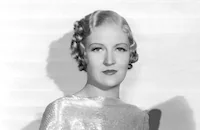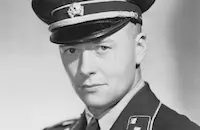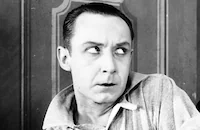Fifth Avenue Girl

Brief Synopsis
Cast & Crew
Gregory La Cava
Ginger Rogers
Walter Connolly
Verree Teasdale
James Ellison
Tim Holt
Film Details
Technical Specs

Synopsis
New York millionaire Alfred Borden, beset with government and union troubles in his business, leaves his office for the day with a reminder from his secretary that it is his birthday. He arrives home to find his wife Martha out with a playboy friend, and his son Tim playing polo. Lonely, he wanders into Central Park, where he meets Mary Grey. Alfred is so impressed with Mary's philosophy of life that when he discovers she is unemployed, he invites her to help celebrate his birthday. Alfred awakens the next morning with a hangover, a black eye, his name in the gossip columns and Mary in the guest room. Discovering that his little spree has rekindled Martha's interest in him, Alfred decides to keep Mary around the house to bring his family together. After he begins to neglect his business, forcing Tim to take over, Martha decides that she better stay at home and pay attention to her husband. His daughter Katherine marries the chauffeur, who then discards his Communist leanings for capitalism. Mary, however, feels that she has brought dissension to the family and leaves the Borden house in tears. When Tim discovers that Mary has been working for his father and not having an affair with him, he realizes that she means too much to him to let her go and he runs after her, picks her up and carries her back into the house.

Director

Gregory La Cava
Cast

Ginger Rogers

Walter Connolly

Verree Teasdale

James Ellison

Tim Holt
Kathryn Adams

Franklin Pangborn
Ferike Boros

Louis Calhern
Theodor Von Eltz

Alexander D'arcy
Cornelius Keefe
Manda Lane
Robert Emmett Keane
Earl Richards
Florence Lake

Jack Carson
Harold Langdon

Dick Hogan
Peggy Stewart
Kathryn Hohn
Crew
Russell Bennett
Pandro S. Berman
Nan Blake
John L. Cass
Perry Ferguson
Robert De Grasse
Howard Greer
Irene Greer
William Hamilton
Edward Killy
Frank Kneedland
Gregory La Cava
Skeets Noyes
Dorothy Panter
Van Nest Polglase
Allan Scott
Sue Shannon
Darrell Silvera
Roy Webb
Robert Wise

Photo Collections
Videos
Movie Clip



Hosted Intro
Film Details
Technical Specs

Articles
Fifth Avenue Girl
Both this film and My Man Godfrey -- in which a millionaire posing as a hobo is brought home by a screwball heiress and ultimately brings her family closer together -- were produced and directed by Gregory La Cava, an experienced and talented filmmaker who had started in the silent era (originally as a cartoonist) and was perhaps now at his peak; Godfrey and Stage Door (1937) had recently brought him Oscar® nominations.
Fifth Avenue Girl is not as well remembered as My Man Godfrey. It certainly wasn't as critically well received at the time either, though it did become a surprise hit and one of RKO's biggest moneymakers of the year. The New York Times thought it a mere trifle, saying it was "too slight an entertainment to be held other than lightly." Variety, on the other hand, called it "good, substantial fun" with "smart appeal for the sophisticates," and raved about Ginger Rogers, whose previous film Bachelor Mother (1939) had opened months earlier and been another non-musical hit for her: "[It] confirms that Rogers holds something more than dancing prowess... [She] demonstrates major league ability as a comedienne for the second successive time... A cleverly devised comedy drama, expertly guided by Gregory La Cava, and having as foundation one of the best scripts of socko dialog that has come out of Hollywood in several months."
Film historian James Harvey, in his book Romantic Comedy in Hollywood, has taken another view on Rogers' and La Cava's creative approaches. La Cava, Harvey argues, tended to design his films around his actors' temperaments and performing styles such that the films themselves became overall extensions of those qualities. Fifth Avenue Girl, Harvey writes, heightens Rogers' own natural deadpan tone, but that is ultimately a weakness, making the film too "straight" and lifeless: "La Cava is taking conscious risks, trying for a kind of bristling, cranky amiability, for example, in the exchanges between the heroine and the millionaire, a mock irritability concealing interest and affection. But...in the Rogers character only the bristle and irritability seem real."
La Cava directed Rogers three times -- in Stage Door, Fifth Avenue Girl and Primrose Path (1940) -- but according to Harvey, he didn't especially admire her. During production of Stage Door, La Cava told an interviewer that the only way he could get Rogers to cry "was to tell her that her house was on fire."
Producer: Gregory La Cava
Director: Gregory La Cava
Screenplay: Gregory La Cava (uncredited); Morrie Ryskind (uncredited, story outline)
Cinematography: Robert de Grasse
Art Direction: Van Nest Polglase
Music: Russell Bennett
Film Editing: William Hamilton, Robert Wise
Cast: Ginger Rogers (Mary Grey), Walter Connolly (Mr. Borden), Verree Teasdale (Mrs. Borden), James Ellison (Mike), Tim Holt (Tim Borden), Kathryn Adams (Katherine Borden), Franklin Pangborn (Higgins), Ferike Boros (Olga), Louis Calhern (Dr. Kessler), Theodor von Eltz (Terwilliger), Alexander D'Arcy (Maitre d'Hotel)
BW-83m.
by Jeremy Arnold

Fifth Avenue Girl
Quotes
Trivia
Notes
The working titles of this film were My Fifth Avenue Girl and The Other Half. Materials contained in the RKO Production Files at the UCLA Theater Arts Library note that the picture finished shooting twelve days ahead of schedule. Louis Calhern was originally cast as Tommy Hopkins, according to the production files. A news item in Hollywood Reporter notes that the film originally featured an unhappy ending until a negative sneak preview prompted the studio to reshoot the ending. This is supported by the material contained in the RKO Script files. In the original version of the produced script, dated June 28, 1939, Mary Grey leaves the Borden house, and although it is implied that Tim Borden follows her, the last shot is that of Mary, walking alone down Fifth Avenue. In the final continuity script, however, Tim catches up to Mary in the park, picks her up and carries her back into the house. Materials contained in the Script Files also note that writer Morrie Ryskind wrote a story outline for the film. In 1940, Ginger Rogers and Edward Arnold starred in a Lux Radio Theater version of this story.

Miscellaneous Notes
Released in United States 1939
Released in United States 1939















